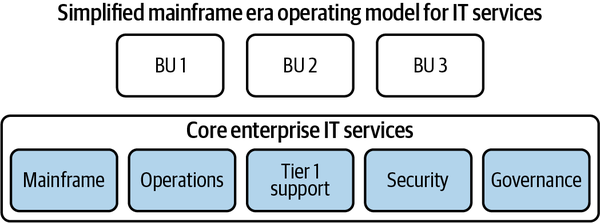Chapter 2. Technology
My first tech job out of college was working as a consultant writing code for a steel company in the south. The technology stack was rather simple back then. We had three generations of mainframes: Burroughs, DEC PDP-11/70, and the brand-new IBM 3090. We wrote in COBOL, Fortran, and Assembler. There were three options for storing data: tape, Db2, and IMS databases. The operating model was simple, too. A small group of people managed the mainframe, the software, and the databases, and the rest of us wrote code.
When an app broke, the person who wrote the code was paged and had to fix it. It was very common that there was one developer per program. This was long before the days of service-oriented architectures, microservices, and even the internet. Running an IT shop was much easier back then because there were fewer technologies to manage, the infrastructure was centrally managed, and almost everyone was writing code in the same languages.
A simplified operating model in my mainframe days looked like Figure 2-1. The mainframe team managed the full stack of the mainframe, which included the infrastructure, the programming languages (such as COBOL, Fortran, and RPG), and the database technologies (IMS, Db2, and so forth).

Figure 2-1. Simplified operating model during the mainframe era, circa 1980s
They also provided tape service, managed the execution of the ...
Get Accelerating Cloud Adoption now with the O’Reilly learning platform.
O’Reilly members experience books, live events, courses curated by job role, and more from O’Reilly and nearly 200 top publishers.

